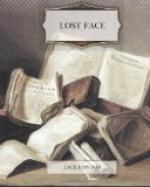All this was unusual for a Yukon Indian, but Klakee-Nah was an unusual Indian. Not alone did he like to render inordinate hospitality, but, what of being a chief and of acquiring much money, he was able to do it. In the primitive trading days he had been a power over his people, and he had dealt profitably with the white trading companies. Later on, with Porportuk, he had made a gold-strike on the Koyokuk River. Klakee-Nah was by training and nature an aristocrat. Porportuk was bourgeois, and Porportuk bought him out of the gold-mine. Porportuk was content to plod and accumulate. Klakee-Nah went back to his large house and proceeded to spend. Porportuk was known as the richest Indian in Alaska. Klakee-Nah was known as the whitest. Porportuk was a money-lender and a usurer. Klakee-Nah was an anachronism—a mediaeval ruin, a fighter and a feaster, happy with wine and song.
El-Soo adapted herself to the large house and its ways as readily as she had adapted herself to Holy Cross Mission and its ways. She did not try to reform her father and direct his footsteps toward God. It is true, she reproved him when he drank overmuch and profoundly, but that was for the sake of his health and the direction of his footsteps on solid earth.
The latchstring to the large house was always out. What with the coming and the going, it was never still. The rafters of the great living-room shook with the roar of wassail and of song. At table sat men from all the world and chiefs from distant tribes—Englishmen and Colonials, lean Yankee traders and rotund officials of the great companies, cowboys from the Western ranges, sailors from the sea, hunters and dog-mushers of a score of nationalities.
El-Soo drew breath in a cosmopolitan atmosphere. She could speak English as well as she could her native tongue, and she sang English songs and ballads. The passing Indian ceremonials she knew, and the perishing traditions. The tribal dress of the daughter of a chief she knew how to wear upon occasion. But for the most part she dressed as white women dress. Not for nothing was her needlework at the Mission and her innate artistry. She carried her clothes like a white woman, and she made clothes that could be so carried.
In her way she was as unusual as her father, and the position she occupied was as unique as his. She was the one Indian woman who was the social equal with the several white women at Tana-naw Station. She was the one Indian woman to whom white men honourably made proposals of marriage. And she was the one Indian woman whom no white man ever insulted.




